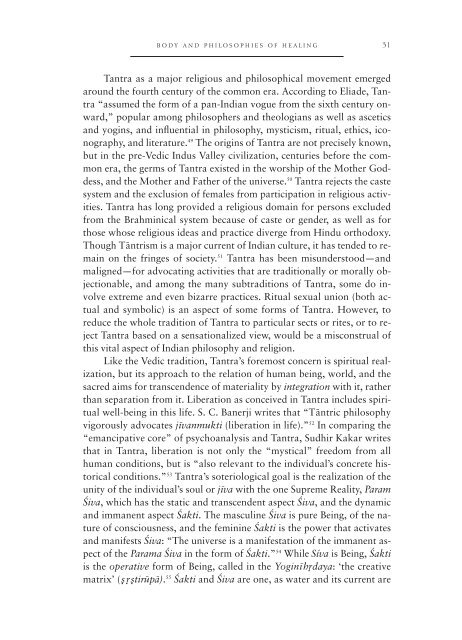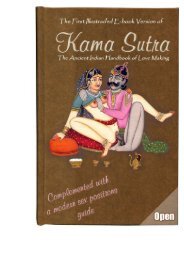body and health in yoga, Ayurveda, and Tantra
body and health in yoga, Ayurveda, and Tantra
body and health in yoga, Ayurveda, and Tantra
You also want an ePaper? Increase the reach of your titles
YUMPU automatically turns print PDFs into web optimized ePapers that Google loves.
ody <strong>and</strong> philosophies of heal<strong>in</strong>g 31<br />
<strong>Tantra</strong> as a major religious <strong>and</strong> philosophical movement emerged<br />
around the fourth century of the common era. Accord<strong>in</strong>g to Eliade, <strong>Tantra</strong><br />
“assumed the form of a pan-Indian vogue from the sixth century onward,”<br />
popular among philosophers <strong>and</strong> theologians as well as ascetics<br />
<strong>and</strong> yog<strong>in</strong>s, <strong>and</strong> <strong>in</strong>fluential <strong>in</strong> philosophy, mysticism, ritual, ethics, iconography,<br />
<strong>and</strong> literature. 49 The orig<strong>in</strong>s of <strong>Tantra</strong> are not precisely known,<br />
but <strong>in</strong> the pre-Vedic Indus Valley civilization, centuries before the common<br />
era, the germs of <strong>Tantra</strong> existed <strong>in</strong> the worship of the Mother Goddess,<br />
<strong>and</strong> the Mother <strong>and</strong> Father of the universe. 50 <strong>Tantra</strong> rejects the caste<br />
system <strong>and</strong> the exclusion of females from participation <strong>in</strong> religious activities.<br />
<strong>Tantra</strong> has long provided a religious doma<strong>in</strong> for persons excluded<br />
from the Brahm<strong>in</strong>ical system because of caste or gender, as well as for<br />
those whose religious ideas <strong>and</strong> practice diverge from H<strong>in</strong>du orthodoxy.<br />
Though T¯antrism is a major current of Indian culture, it has tended to rema<strong>in</strong><br />
on the fr<strong>in</strong>ges of society. 51 <strong>Tantra</strong> has been misunderstood—<strong>and</strong><br />
maligned—for advocat<strong>in</strong>g activities that are traditionally or morally objectionable,<br />
<strong>and</strong> among the many subtraditions of <strong>Tantra</strong>, some do <strong>in</strong>volve<br />
extreme <strong>and</strong> even bizarre practices. Ritual sexual union (both actual<br />
<strong>and</strong> symbolic) is an aspect of some forms of <strong>Tantra</strong>. However, to<br />
reduce the whole tradition of <strong>Tantra</strong> to particular sects or rites, or to reject<br />
<strong>Tantra</strong> based on a sensationalized view, would be a misconstrual of<br />
this vital aspect of Indian philosophy <strong>and</strong> religion.<br />
Like the Vedic tradition, <strong>Tantra</strong>’s foremost concern is spiritual realization,<br />
but its approach to the relation of human be<strong>in</strong>g, world, <strong>and</strong> the<br />
sacred aims for transcendence of materiality by <strong>in</strong>tegration with it, rather<br />
than separation from it. Liberation as conceived <strong>in</strong> <strong>Tantra</strong> <strong>in</strong>cludes spiritual<br />
well-be<strong>in</strong>g <strong>in</strong> this life. S. C. Banerji writes that “T¯antric philosophy<br />
vigorously advocates j¯ıvanmukti (liberation <strong>in</strong> life).” 52 In compar<strong>in</strong>g the<br />
“emancipative core” of psychoanalysis <strong>and</strong> <strong>Tantra</strong>, Sudhir Kakar writes<br />
that <strong>in</strong> <strong>Tantra</strong>, liberation is not only the “mystical” freedom from all<br />
human conditions, but is “also relevant to the <strong>in</strong>dividual’s concrete historical<br />
conditions.” 53 <strong>Tantra</strong>’s soteriological goal is the realization of the<br />
unity of the <strong>in</strong>dividual’s soul or j¯ıva with the one Supreme Reality, Param<br />
Íiva, which has the static <strong>and</strong> transcendent aspect Íiva, <strong>and</strong> the dynamic<br />
<strong>and</strong> immanent aspect Íakti. The mascul<strong>in</strong>e Íiva is pure Be<strong>in</strong>g, of the nature<br />
of consciousness, <strong>and</strong> the fem<strong>in</strong><strong>in</strong>e Íakti is the power that activates<br />
<strong>and</strong> manifests Íiva: “The universe is a manifestation of the immanent aspect<br />
of the Parama Íiva <strong>in</strong> the form of Íakti.” 54 While Síva is Be<strong>in</strong>g, Íakti<br />
is the operative form of Be<strong>in</strong>g, called <strong>in</strong> the Yog<strong>in</strong>¯ıhÓrdaya: ‘the creative<br />
matrix’ (ÓsÓrÓstirūpā). 55 Íakti <strong>and</strong> Íiva are one, as water <strong>and</strong> its current are



